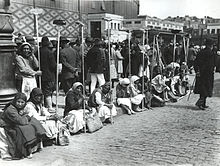Whitewash

Whitewash, calcimine, kalsomine, calsomine, or lime paint is a type of
, CaCO3), sometimes known as "whiting". Various other additives are sometimes used.Use as paint

Whitewash cures through a reaction with carbon dioxide in the atmosphere to form calcium carbonate in the form of calcite, a type of reaction generally known as carbonation or by the more specific term, carbonatation.
It is usually applied to exteriors, or interiors of rural
Whitewash is especially compatible with masonry because it is absorbed easily and the resultant chemical reaction hardens the medium [citation needed].
Lime wash is pure slaked lime in water. It produces a unique surface glow due to the double refraction of calcite crystals. Limewash and whitewash both cure to become the same material.
When whitewash or limewash is initially applied, it has very low opacity, which can lead novices to overthicken the paint. Drying increases opacity and subsequent curing increases opacity even further.
Limewash relies on being drawn into a substrate unlike a modern paint that adheres to the surface. The process of being drawn in needs to be controlled by damping down. If a wall is not damped, it can leave the lime and pigments on the surface powdery; if the wall is saturated, then there is no surface tension and this can result in failure of the limewash. Damping down is not difficult but it does need to be considered before application of the limewash.[2]
Additives
Additives traditionally used include
.Whitewash is sometimes coloured with
.The blue laundry dye (such as Reckitt's "Dolly Blue" in the UK, Ireland and Australia, Loulaki in Greece, or Mrs. Stewart's Bluing in North America), formerly widely used to give a bright tinge to boiled white textiles, was a common 19th century addition.
Historically, pig's blood was added to give the colour Suffolk pink, a colour still widely used on house exteriors in some areas of the UK. If animal blood is applied excessively, its iron oxide can compromise the lime binder's strength.
Pozzolanic materials are occasionally added to give a much harder wearing paint finish. This addition creates a short open time and therefore requires timely application of the altered paint.
Linseed oil is sometimes added (typically 0.5-2%) to improve adhesion on difficult surfaces.
Cement addition makes a harder wearing paint in white or grey. Open time is short, so this is added at point of use. Cement restricts the breathable aspects of the limewash and is inadvisable for preserved historic buildings.
Dilute
Limitations
Basic limewash can be inadequate in its ability to prevent rain-driven water ingress. Additives are being developed but these have the potential for affecting free vapor permeability. For this reason silicate paints, more common in Germany, are gaining popularity in the UK over limewash.
Applications
Orchards

Whitewash is applied to trees, especially fruit trees, to prevent
Dairy barns

In the middle of the 20th century, when
A traditional animal barn contains a variety of extremely rough surfaces that are difficult to wash and keep clean, such as stone and brick masonry, and also rough-cut lumber for the ceiling. If left alone, these surfaces collect dust, dirt, insect debris and wastes, and can become very dirty.
Whitewash aids in sanitation by coating and smoothing over the rough surfaces. Successive applications of whitewash build up layers of scale that flake off and, in the process, remove surface debris. The coating also has antimicrobial properties that provide hygienic and sanitary benefits for animal barns.[4]
Other uses
Whitewash was painted on the internal walls of
Removal
While calcimine was generally stable with oil paint, current latex paints blister and peel. No success has been reported with primers and other glues over top of a peeling wall. The only approach is to scrape it off. The chalk releases the paint in large flakes or small chips. While working, the wall sections of paint will appear to be solid and later come off easily. It is a long process.
In popular culture
The incident of Tom Sawyer whitewashing a fence as punishment is a famous image in American literature. It appears in The Adventures of Tom Sawyer written in 1876 by Mark Twain.
In the 1934 film, Fugitive Lovers, Madge Evans drops a bottle of cosmetics that she calls her "Calcimine".
Metaphorically, whitewashing refers to suppression or "glossing over" (possibly a close parallel construction) of potentially damaging or unwelcome information. In many Commonwealth areas, a whitewash refers to a game in which one side fails to score at all; the usage is especially found in cricket.[7]
See also
- Lime plaster
- Lime mortar
- Silicate paint
References
- ISBN 9780813150192.
- ^ "How to Apply Limewash - Limewashing - Buy Traditional Limewash". www.mikewye.co.uk. Archived from the original on 19 October 2016. Retrieved 3 May 2018.
- ^ "California Agriculture PDF" (PDF). ucce.ucdavis.edu. June 1970. Archived (PDF) from the original on February 22, 2014. Retrieved February 12, 2014.
- ^ "Fias Co Farm/Recipes- whitewash". Fiascofarm.com. Archived from the original on 2013-07-08. Retrieved 2014-02-03.
- S2CID 162165859.
- ^ Rothman, Gordon L.; Dennis, Peter (2013). World War II Tactical Camouflage Techniques. p. 52.
- ^ “Whitewash”. Merriam-Webster.com Dictionary, Merriam-Webster. Accessed 21 Mar. 2020.
